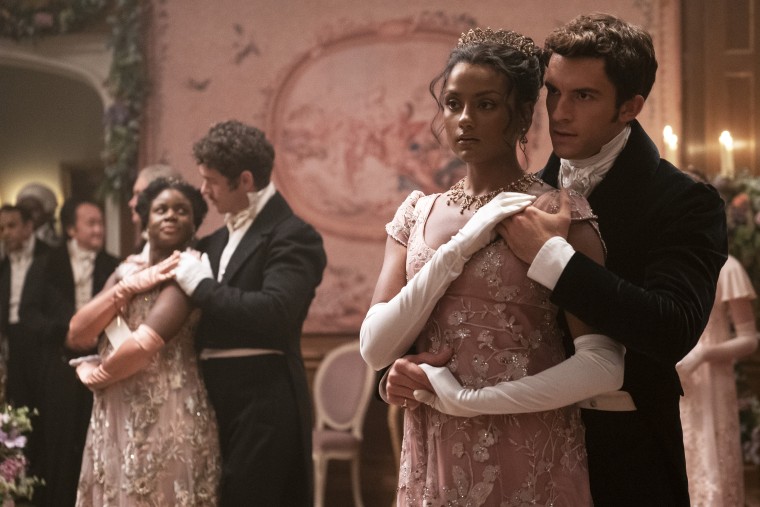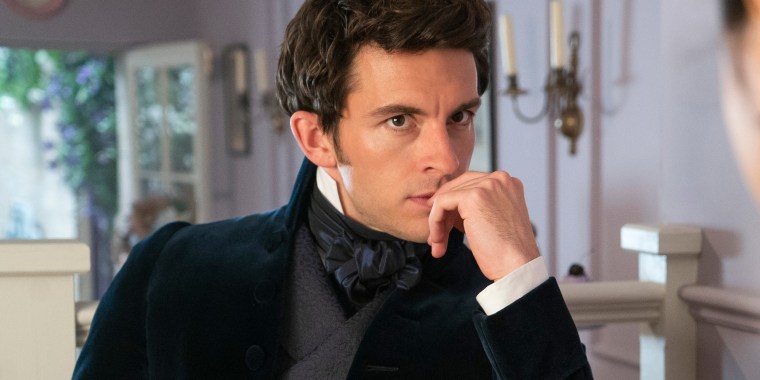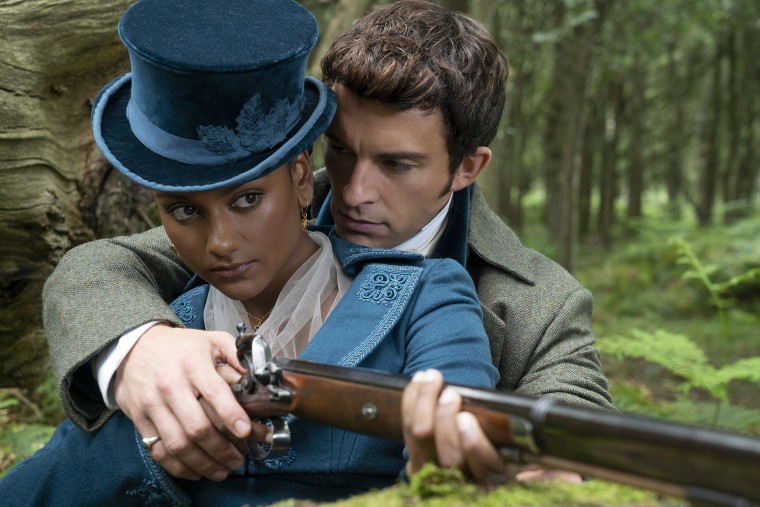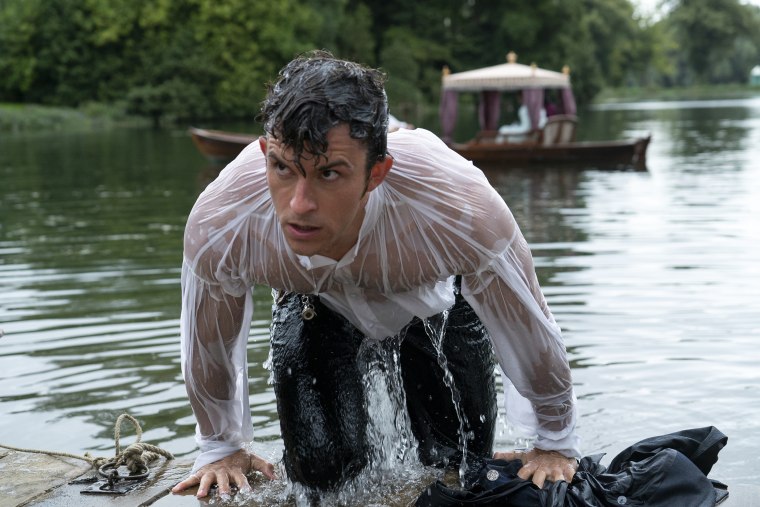After two seasons, “Bridgerton” has practically become synonymous with steamy romance. Featuring intimate scenes taking place on all manner of surfaces — from staircases to tree trunks — it’s obvious why the Regency-era show has garnered its reputation.
And while the show could easily be belittled as a mere romantic romp, ahead of the season two premiere, actor Jonathan Bailey said the show’s depiction of intimacy is about so much more than just entertainment.
According to Bailey, who leads the sophomore season as Anthony Bridgerton, the scenes are filtered through the female gaze, a film term that classifies women as active participants in desire, rather than objects of desire.
“The female gaze is so important because there are many ways people communicate by sex, and what sex means, and what your body means to someone else," Bailey told Entertainment Weekly. "It’s important that there’s an inversion of sexuality and how people are exploited in the storytelling of sex.”

How does "Bridgerton" accomplish this through scenes that are often nonverbal? Well, there’s an entire job for that — and Lizzy Talbot, the intimacy coordinator for “Bridgerton,” has it. Talbot is responsible for choreographing scenes of sex and nudity and advocating for the safety and comfort of the actors.
Talbot spoke to TODAY about the unique responsibilities of the job of an intimacy coordinator, working on the set of season two and how “Bridgerton” reframes desire.
What is an intimacy coordinator? Let one explain
The role of an intimacy coordinator combines choreography and advocacy. Think of Talbot as the artist crafting the movement of simulated sex.
But the job doesn't stop there: She also helps with scenes of platonic intimacy, such as moments between a mother and child, and scenes involving nudity, such as bathing or birthing scenes.
Talbot first trained as a fight director, helping to choreograph movie stunts. Through this work, she noticed that while scenes involving simulated violence went smoothly, scenes of intimacy would "fall apart," Talbot told TODAY.
"There was a complete lack of any standards, protocols and techniques regarding the intimacy part," she said.

As an intimacy coordinator, Talbot's task is to bring the same level of standards to intimacy work she once brought to fight scenes. The goal? Prevent the kind of harm that has occurred in the past when filming those vulnerable scenes.
"It makes sense because with fight work, you're looking at choreography, you're looking at safety, you're looking at risk management, you're looking at advocacy for the actors," she said. "And it became the same thing."
“Whenever you know that there is harm being done to actors, it pulls you out of the story."
Lizzie Talbot
For Talbot, the standardization of intimacy scenes over the past few years has preserved actor safety and changed the viewing experience for audiences.
“Whenever you know that there is harm being done to actors, it pulls you out of the story,” Talbot said.
"When you are watching a simulated sex scene and you know the actors had fun, and they really enjoyed doing it, and everyone was working as a team, you can really lose yourself in them so much more," she added.
In addition to “Bridgerton,” Talbot has also worked on the sets for “The Witcher,” “Anatomy of a Scandal” and “The Nevers.”
The female gaze has been present on set since 'day one'
The female gaze is a film theory term defined in opposition to the idea of the male gaze, coined by feminist film theorist Laura Mulvey in 1975. The male gaze looks at the female body as an object. The female gaze depicts women as subjects with agency.
The show’s focus on the female gaze has been present since the beginning, Talbot said.
"Day one, it was so clear that this wasn't going to be your typical show in regards to sex and nudity, it was going to have a very different feel," Talbot said. "And what we were going to do was position everything from what mainly women wanted to see and perhaps hadn't seen before."
She worked with a ‘different kind of intimacy’ in season 2
While season two has fewer intimate scenes than its predecessor, it does pay off with a montage of Kate (Simone Ashley) and Anthony as they finally give in to their sexual tension in episode seven, set to a classical cover of “How Deep Is Your Love.”
The season's relatively sparse sex scenes didn't mean Talbot’s workload was any lighter this time around. She just worked with “a different kind of intimacy” in season two, she said.
For example, in episode three, Kate holds Anthony's hand close to her chest to calm him after her bee sting sends him into a panic. Their eyes meet, their foreheads touch and their heads move closer — until a neighing horse interrupts the moment.
Later on, in episode four, the pair have an explosive fight in Anthony's office. Kate says she hates Anthony. But as he draws closer, she doesn't pull away. Anger turns to attraction, with their lips a breath apart — before Daphne walks in.
These moments, plus longing glances and lingering touches exchanged throughout the season, turn the season into an agonizing (and delectable) slow burn romance.

"I think what season two shows is just the breadth of intimacy," Talbot said. "It's not always scenes of simulated sex and nudity, it extends so much more into build-up."
Part of Talbot's job is research, doubly so for 'Bridgerton'
“Bridgerton” puts a new perspective on an era that has long been a pop culture favorite, ever since Jane Austen published her first novels and spurred an entire sub-genre of romance novels still going to this day.
“We’re looking at, obviously, Regency England,” Talbot said. “But we’re also looking at Regency England from a female point of view."
Talbot says that while Austen's novels were published during the era and about the era's women, they couldn't be written "explicitly from the female gaze." "Bridgerton,” on the other hand, could be — and was.
Talbot worked with Bridgerton's historical advisor, Hannah Greig, to explore historical depictions of sex in Regency England. What Talbot found was that even some sex acts that may feel more modern, such as oral sex, were, in fact, depicted in the time period.
An important part of this female-centered depiction of sex was the show’s focus on foreplay — hence all the long gazes and kissing scenes. “It’s not always about a penetrative orgasm,” Talbot said.
But foreplay in Regency garb has an extra complication: Layers. “A huge part of doing any intimacy scene in the Regency period is how to get the costumes off, because they’re not easy,” Talbot told Insider. It took two days to film episode seven’s sex scene, in part because of all the components of Kate and Anthony’s costumes.
Talbot had a few tricks that Ashley took away from the experience.
“I learned some stuff from her,” Ashley told Glamour. “Whatever the position might have been, she would say, ‘Well, let’s make sure that this is happening so that the woman comes as well.’” She added that she felt "very safe" working with Bailey.
The 'gift' of working on 'Bridgerton'
Returning to set for season two felt like “coming home,” Taylor said. This season, she had a new couple to focus on — and she said working with Bailey and Ashley was a “gift.”
She said the pair has natural chemistry, visible at the start of the casting process (even through Zoom). “They connect really easily, they understand one another. They’re very giving and they’re very caring,” she said.
Bailey in particular brought a "lightness" during a filming process that often gets very serious and people start speaking in "hushed voices."

"It can be quite an intense environment but that's not really how I like to work, and it's certainly not how Jonny likes to work," she said. "... I think we got far more out of it that way."
What's next?
After the success of "Bridgerton" season two, smashing viewership records in one weekend, many are excited to see what the Netflix series has in store.
"Bridgerton" is based on the eight-book series of the same name by Julia Quinn, with each addition telling the love story of a different sibling in the family.
So far, each season has followed the order of the books. Based on this precedent, many expect season three to draw inspiration from the third book, "An Offer From a Gentleman," which spotlights Benedict Bridgerton (Luke Thompson).
But creator Shonda Rhimes herself has said the show is "not necessarily going in order," so Benedict may not be next at bat (or pall-mall mallet) for love.
Whatever sibling is up next to face the drama and scandal of the marriage mart, we can expect their romance to bring both the steam and the feels.
